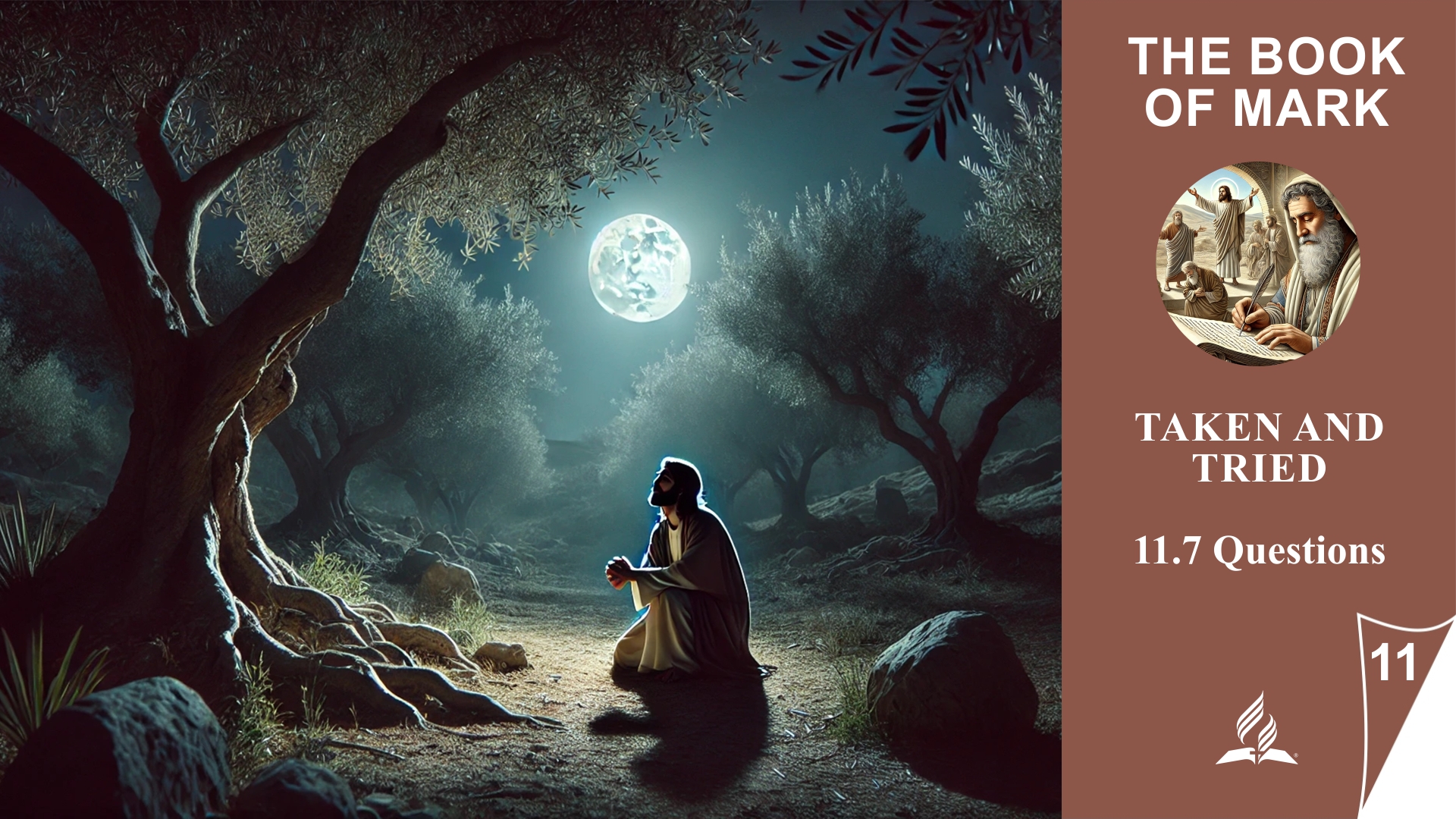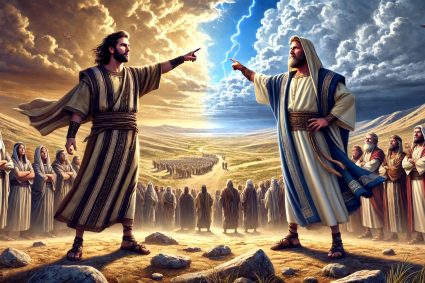



1.How can we recognize, solely by reading what Jesus predicted in Mark 14:9, that another of Jesus’ predictions—a highly unlikely prediction given the circumstances under which it was made—is actually being fulfilled?
In Mark 14:9, Jesus predicts: “Truly I tell you, wherever the gospel is preached throughout the world, what she has done will also be told in memory of her.”
This statement refers to the action of a woman who anointed Jesus with expensive oil. Jesus explains that this deed will become known worldwide whenever the gospel is proclaimed. Given the circumstances at the time, this prediction seemed extremely unlikely. Jesus was not yet a globally recognized leader, and the idea that his message and the memory of this woman would be proclaimed “throughout the world” was hard to imagine.
The fact that today, solely through reading the Gospels, we know about this woman and her act shows that Jesus’ prediction has indeed been fulfilled. Christianity has spread globally, and the story of this woman has been passed down through generations in many countries and cultures.
By reading Mark 14:9, we thus recognize that a seemingly unlikely prediction—the global recognition of a small, inconspicuous act—has actually come true. This reinforces our confidence in other prophecies of Jesus, including those that seemed unlikely or impossible under the circumstances at the time.
2.Compare Judas and Peter and juxtapose them. In what ways were they similar, and how did their behaviors differ in the Passion narrative?
Judas and Peter are central figures in the Passion narrative of Jesus, both closely involved in the events leading to Jesus’ arrest and crucifixion. They share similarities but also have significant differences in their behavior and responses to their actions.
Similarities:
-
Proximity to Jesus: Both Judas and Peter were among the twelve closest disciples of Jesus. They accompanied Him on His journeys, listened to His teachings, and witnessed His miracles. They both had a close relationship with Jesus.
-
Betrayal: Both disciples betrayed Jesus in the Passion narrative. Judas betrayed Jesus by handing Him over to the chief priests and Roman soldiers. Peter, on the other hand, denied Jesus three times when confronted about His followers.
-
Prediction of Betrayal: Jesus predicted their impending failures. He announced that Judas would betray Him (Mark 14:18-21) and also foretold that Peter would deny Him three times before the rooster crowed (Mark 14:30).
Differences:
-
Intent and Action: Judas’ betrayal was a deliberate and conscious act, as he made a deal with the chief priests to hand over Jesus for thirty pieces of silver (Mark 14:10-11). His betrayal was motivated by greed or political reasons. In contrast, Peter’s denial was unplanned. He acted out of fear and weakness in a stressful and dangerous situation, denying Jesus to protect himself when faced with the possibility of arrest or persecution.
-
Repentance and Reaction to Betrayal: After his betrayal, Judas reacted with guilt and deep despair. He attempted to return the money and repented for what he had done (Matthew 27:3-5). However, his remorse did not lead to repentance; instead, he committed suicide. Peter, on the other hand, showed deep regret after his denial. After the rooster crowed, he remembered Jesus’ words and “wept bitterly” (Mark 14:72). Unlike Judas, Peter sought forgiveness and later returned as one of the leading apostles in the community.
-
Outcome: The greatest difference lies in the consequences of their betrayals. Judas’ story ends tragically with his death, while Peter receives a second chance and is forgiven by Jesus after the resurrection (John 21:15-19). Peter ultimately becomes an important leader of the early church. Judas, however, is remembered in tradition as the one who handed Jesus over, marking him negatively in Christian history.
Conclusion:
Both Judas and Peter committed betrayals in the Passion story of Jesus, but they differ significantly in the intent behind their actions and their responses afterward. While Judas acted deliberately and calculatedly, Peter was overwhelmed by fear. The most important difference is how they dealt with their guilt: Judas fell into despair, whereas Peter showed remorse and sought forgiveness. This led Peter to take on a central role in the early church, while Judas’ story ended tragically.
3.Discuss the significance of the Lord’s Supper. How can we make it more meaningful in our church and involve more members in the celebration?
Significance of the Lord’s Supper
The Lord’s Supper, also known as the Eucharist or Communion, is one of the central sacraments in Christianity and commemorates the last meal Jesus shared with His disciples on the evening before His crucifixion. In Mark 14:22-24, Jesus says: “Take, eat; this is my body.” “This is my blood of the covenant, which is poured out for many.”
The Lord’s Supper symbolizes Jesus’ dedication and His sacrifice on the cross for the forgiveness of sins. It is an act of remembering His love and redemptive work. Furthermore, it signifies the community of believers united in Christ. By breaking the bread and drinking the wine, Christians not only share in the memory of Jesus’ death but also in the hope of eternal life made possible through His resurrection.
How to Make the Lord’s Supper More Meaningful
-
Deeper Spiritual Preparation: One way to make the Lord’s Supper more meaningful is to provide believers with more space for spiritual preparation. This could involve Bible readings, silent meditation, or prayer to reflect on the significance of Jesus’ sacrifice and their personal relationship with Him.
-
Integration into the Worship Service: The Lord’s Supper could be more deeply integrated into the worship service. Instead of a separate, quick ceremony, it could be celebrated as the highlight of the service, with sermons and hymns thematically focused on Jesus’ sacrifice. This approach would emphasize the Eucharist’s significance for the community and faith.
-
Shared Prayer and Thanksgiving: After distributing the bread and wine, the congregation could engage in a collective prayer of gratitude for Jesus’ sacrifice. This could strengthen the sense of community and highlight the spiritual value of the Lord’s Supper.
-
Visualization and Symbolism: Using symbols, such as a special table for the Lord’s Supper or displaying a cross that points to Jesus, can deepen the visual significance of the celebration. A solemn altar with candles, bread, and wine could make the ceremony more impactful.
How to Involve More Members in the Celebration
-
Children and Families: Many churches have special programs for children during the worship service. One way to involve more members in the Lord’s Supper is to actively include children and families by providing age-appropriate explanations of its significance and encouraging families to participate together.
-
Expanding Roles: More church members could be actively involved in the celebration, such as by distributing bread and wine or reading scripture passages. This involvement can help believers feel more connected to the ritual.
-
Promoting Unity and Community: The Lord’s Supper could be complemented by communal activities like a shared meal or a gathering after the service. Such settings could strengthen the fellowship of believers and foster a deeper sense of belonging.
-
Encouraging Active Participation: The church could encourage believers who might be hesitant or unsure to participate regularly in the Lord’s Supper. This could be supported through pastoral conversations, educational programs, or special prayer evenings to remove barriers and promote participation.
Conclusion
The Lord’s Supper is a deeply spiritual and meaningful celebration that centers on Jesus’ sacrifice and love. By preparing spiritually, emphasizing symbolism, and actively involving all church members, we can deepen the significance of the Lord’s Supper and encourage more people to participate. The community formed through sharing bread and wine is a powerful symbol of unity in faith and reminds us of the core message of the Gospel.
4.Discuss the fact that God said “no” to Jesus’ prayer in Gethsemane. What does it mean when God says “no” to us?
God’s “No” to Jesus’ Prayer in Gethsemane
In Gethsemane, Jesus prays shortly before His arrest: “Abba, Father, everything is possible for you. Take this cup from me. Yet not what I will, but what you will.” (Mark 14:36)
This prayer reveals Jesus’ human side, fearing the impending pain and suffering. He asks God to remove the “cup” of suffering from Him but simultaneously submits to God’s will. Ultimately, Jesus’ prayer was not answered in the way He had hoped: God said “no,” and Jesus had to endure the path of suffering to the cross.
However, God’s “no” to this prayer was not an expression of rejection or indifference to Jesus’ pain but part of God’s greater plan for humanity. Through Jesus’ suffering and death, redemption for all people was made possible. God’s “no” ultimately served a higher purpose, which Jesus accepted in obedience.
What It Means When God Says “No” to Us
-
God’s Will Is Greater Than Our Understanding: When God says “no” to our prayers, it can often be difficult to accept because we may not understand it from our limited perspective. Just as Jesus in Gethsemane could not fully comprehend the forthcoming redemption, we cannot always see God’s larger plan. A “no” often means that God has something else planned for us that is for our good or serves a greater purpose.
-
Trusting in God’s Plan: A “no” from God invites us to develop a deeper trust in His plan. Just as Jesus prayed, “Not my will, but yours be done,” a divine “no” challenges us to subordinate our own will and desires to God’s will. It is a call to believe in God’s wisdom and love, even when the answer is not what we hoped for.
-
God Is Always with Us, Even in “No”: Jesus’ prayer in Gethsemane shows that God is not distant or indifferent despite the “no.” God was with Jesus throughout His suffering, giving Him strength and carrying Him through the cross. Similarly, God is with us even when He says “no” to our requests. He does not abandon us but provides the strength to face the challenges ahead.
-
A “No” Can Lead to Something Greater: Often, we later realize that God’s “no” led us to something better or deeper than we could have ever imagined. The Bible has many examples where a “no” from God in the present leads to a greater blessing in the future. God’s “no” is not the end but often the beginning of something new that He wants to work in our lives.
-
Developing Patience and Obedience: A “no” from God is also an opportunity to learn patience and obedience. Just as Jesus submitted to the Father’s will, we are invited to practice patience and trust that God’s timetable is different and better than ours. It challenges us to rely not on the fulfillment of our desires but on God’s goodness.
Conclusion
When God says “no” to us, it may initially be painful or disappointing. However, Jesus’ prayer in Gethsemane shows that God’s “no” can be part of a larger plan that we may only understand later. It calls us to develop trust, practice obedience, and cultivate patience, knowing that God remains with us and guides us through difficult times. A “no” from God is not the end of our relationship with Him but often the beginning of a deeper understanding of His will and love.
5.Although Peter greatly disappointed Jesus through his denials, Jesus did not reject him. What hope can you draw for yourself from this fact?
The story of Peter’s denials and his later restoration by Jesus is a powerful source of hope. It shows that even a severe failure does not mean the end of our relationship with God. Here are some aspects from which we can draw hope:
-
Forgiveness and Grace: Jesus did not reject Peter despite his three denials. This demonstrates that God’s grace is greater than our failures. No matter how severe our mistakes may be, God always offers us the possibility of forgiveness and renewal.
-
A Second Chance: After his failure, Peter was given a new opportunity to follow Jesus and play a significant role in the church. This gives us hope that God continually provides us with new chances to fulfill our callings and realize His plans in our lives.
-
God Sees Our Potential: Jesus was aware of Peter’s weaknesses but also saw his potential. This gives us hope that God does not define us solely by our failures but assesses us based on our true potential and guides us to achieve it.
-
God Remains Faithful: The fact that Jesus did not reject Peter shows that God remains with us even in our darkest moments. We can be confident that God does not abandon us when we fail but instead leads us on the path of healing and renewal.
From this story, we can draw hope that God loves us, forgives us, and always gives us the opportunity to start anew, regardless of our mistakes or weaknesses.
(Visited 16 times, 1 visits today)




















